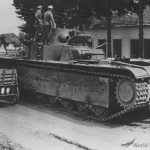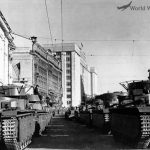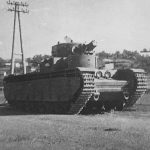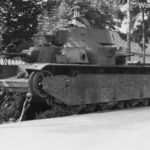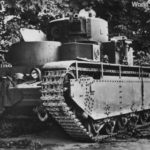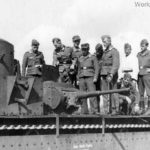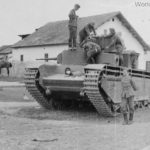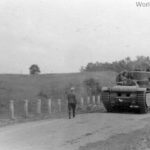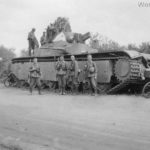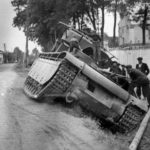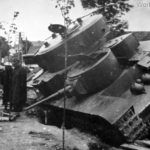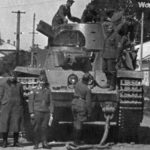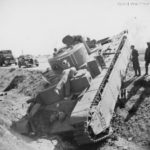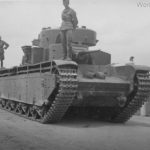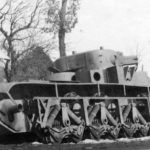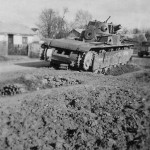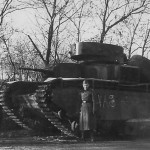T-35 rear
T-35 rear
T-35 744-62
T-35 537-70
T-35 537-70
715-62 at Kummersdorf
T-35 744-62
T-35 744-62
T-35 744-62
T-35 52
T-35 228-43
Tank of the 68th Tank Regiment, 34th Tank Division
T-35 51
T-35 50
T-35 49
T-35 48
Tanks during Military parade
T-35 47
T-35 36
T-35 1941 3
T-35 tank No183-8 near Lvov, 1941
T-35 Суховоля/Sukhovola
T-35 44
T-35 35
T-35 39
T-35 from 67th Tank Regiment, Ukraine 1941 2
Tank prototypes on parade T-35 1 is on the right and T-35 2 is on the left
T-35 1941 2
T-35 rear view 1941
First T-35 prototype
German soldiers atop an abandoned T-35
T-35 32
T-35 0197-7 from the tank regiment of the Academy of Armored Troops Moscow November 1941
T-35 0183-3 Білий Камінь (Bilyj Kamin, Ukraine) 1941
Blown up T-35 148-39 and BT-5, Verba near Dubno 1941
T-35 from 67th Tank Regiment, Ukraine 1941 3
Soviet multi-turreted heavy tank T-35, Новый Ярычев (Novyy Yarychev)
T-35 Novyy Yarychev near Lvov
T-35 from 67th Tank Regiment, Ukraine 1941 4
T-35 988-16, Золочев (Zolochev)
German Luftwaffe soldiers with T-35
T-35 No 234-42 from 68th Tank Regiment, Lvov 1941
T-35 228-43 got stuck in a ditch, Lvov area 1941
Soviet multi-turreted heavy tank T-35 42
T-35 got stuck in a ditch
First prototype T-35-1 at the Bolshevik factory July 15, 1932
T-35 45
One of the first T-35 tanks and T-27 Charkov November 1st, 1933
T-35 model 1939 2
T-35 986-16 of 67th Tank Regiment 34th Division
T-35 0200-0 model 1938 of the 67th Tank Regiment, Verba 1941
T-35 front view, Новый Ярычев (Novyy Yarychev)
Soviet multi-turreted heavy tank T-35
Wehrmacht bicycle troops and T-35, 1941
Abandoned T-35 of the 67th Tank Regiment
A crew of T-35 on maneuvers, 14th Armored Brigade, Kiev Military District, Autumn 1939
T-35 tank of the 68th Tank Regiment, 34th Tank Division 1941
T-35 988-15 Zolochiv/Золочів 1941/1942
Heavy tank T-35 0183-3 of the 67th Tank Regiment
T-35 of the 67th Tank Regiment, 34th Tank Division Red Army
T-35 soviet heavy tank model 1939
T-35 abandoned on the roadside during the fighting in Ukraine in June-July 1941
T-35 soviet heavy tank 1
Details of the turret of Soviet tank T-35 228-43
Intact heavy tank T-35 abandoned by its crew due to a malfunction
Kradmelder posing with abandoned heavy tank T-35, Ukraine 1941
Soviet multi-turreted heavy tank T-35. T-28 in the background
T-35 soviet heavy tank 29
T-35 744-62, Horodok near Lviv Ukraine 1941
T-35 of the 68th Tank Regiment
T-35 Kharkov August 1942 2
T-35 288-43 Городок (Horodok near Lviv) 1941 2
Soviet heavy tank T-35 744-62 (model 1939), Ukraine Summer 1941
T-35 288-43 Городок (Horodok near Lviv) 1941
soviet heavy tank T-35 abandoned by the Red Army in the summer of 1941
German soldier and civilians atop T-35, Yariczov (Новий Яричів) Ukraine 1941
T-35 soviet heavy tank 23
Soviet heavy tank T-35 fitted with radio antenna
T-35 soviet heavy tank. Abandoned by the Red Army in the summer of 1941
T-35 Kharkov August 1942
T-35 soviet heavy tank 14
T-35 200-5 of the 67th Tank Regiment abandoned by its crew due to a malfunction
T-35 0183-3 frontal view, Bilyj Kamin, Ukraine
T-35 belonged to 34th Tank Division, 8th Mechanized Corps, Ukraine 1941
German soldiers poses atop a T-35 of the 67th Tank Regiment, Ukraine 1941
Heavy tank T-35 lies abandoned by the roadsise in summer of 1941
T-35 soviet heavy tank somewhere on Eastern Front 1941
T-35 Kharkov 1941/1942
German soldiers poses atop a T-35, Kharkov Eastern Front winter 1941/1942
T-35 0183-3 tank abandoned by its crew due to a malfunction
German soldiers poses atop a T-35 0183-3, Eastern Front 1941
Soviet multi turret heavy tank T-35. Armament: 76.2 mm cannon model 27/32, 2 × 45 mm 20K guns and 5 or 6 × 7,62mm DT machine guns.
Production: 61 tanks. German designation: Panzerkampfwagen T–35A 751(r) or Panzerkampfwagen T-35C 752(r).
Soviet heavy tank of interwar period. It was developed in 1931-1932 by engineers of the Specialized Design Bureau under general supervision of N.V. Barykov. It was the first Soviet heavy tank launched into mass production – in 1933-1939 at the Kharkov Locomotive Plant. Within several small batches 59 serial machines were produced. The T-35 was a five turret heavy tank of classical design, with gun and machine guns , and was intended to support infantry and qualitative strengthening of tank formations when breaking through the heavily fortified positions of the enemy. The T-35 is the world’s only serially produced five turret tank and the most powerful tank of the Red Army in the 1930s.
Since 1933, the T-35 tanks were in service with the 5th Heavy Tank Brigade of the Red Army, which in 1936 was assigned to the reserve of the Main Command together with the rest of the HTB. Until 1941 T-35 did not take part in any combat operations, but were limitedly used in maneuvers and exercises and often used in military parades, being a visible manifestation of the military power of the USSR. The T-35s took part in battles of the initial stage of the Great Patriotic War as part of the 34th Tank Division of the Kiev Army, but were lost very quickly, mainly due to technical faults (only seven tanks were lost in battle). In autumn 1941 four T-35 tanks took part in the battles for Kharkiv as part of a separate anti-tank detachment. All of them were lost in action.
By the end of the 1920s the armoured forces of the RKKA had at their disposal light tanks T-18 (MS-1), perfect enough for their time. Heavier vehicles, however, were mainly represented by tanks known in the USSR as Ricardo – British heavy tanks Mk. V, which fought in World War I, thoroughly worn out and by the end of the 1920s quite obsolete.
Work on creating their own medium and heavy tanks began in the USSR back in the late 1920s, but the lack of Soviet designers’ experience in the field of tank construction did not allow them to create full-fledged combat vehicles. In particular, the attempt of the Design Bureau of the Armoury and Machine gun Association to develop a heavy breakthrough tank ended in nothing. This 50-ton combat vehicle was supposed to carry armament of two 76-mm guns and five machine guns. Only a wooden model of the tank was built, after which in early 1932 all work on this project was stopped, although the tank managed to get the T-30 index. The work of the “prison” Design Bureau of the AutoTank Diesel Department of the OGPU Economic Department, which worked on the 75-ton tank of the breakthrough, was completed in a similar way. As a matter of fact, at the initial stage of design of these vehicles their futility was already evident – the projects had a whole range of drawbacks that excluded the possibility of building these vehicles.
In March 1930 a mixed Soviet-German group headed by Edvard Grotte started designing the medium tank. Although the medium tank TG created under the leadership of Grotte also proved unusable for a number of reasons and did not go into series, in the course of this work the Soviet staff gained some experience which enabled them to start designing heavy combat vehicles. After the TG was discontinued, a specialized Design Bureau was created from the Soviet engineers working with Grotte, whose task was to develop their own heavy tank. The Design Bureau was headed by N. V. Barykov, who had previously worked as Grotte’s deputy. The Design Bureau also included designers M. P. Siegel, B. A. Andrykhevich, Y. M. Gakkel, Y. V. Obukhov and others.
The task from the Department of Mechanisation and Motorisation (UMM) of the RKKA stated: “By August 1, 1932, to develop and build a new 35-tonne breakout tank of the TG type”. Due to the expected mass, the prospective tank was designated the T-35. When designing this vehicle, the designers relied on a year and a half of experience working on the TG, as well as on the results of testing the German Großstraktor tanks at the range near Kazan and the materials of the commission of S.A. Ginzburg to purchase prospective armoured vehicles in Great Britain.
The work was going on at a rapid pace. Already on February 28, 1932 the Deputy Chief of the RKKA UMM G. G. Bokis reported to M. N. Tukhachevsky, at that time – to the Chief of Armament of the RKKA: “Work on the T-35 (former TG) is going at a rapid pace, and failure of the completion date is not planned …”. The assembly of the first prototype, designated T-35-1, was completed on August 20, 1932, and on September 1 the tank was shown to the representatives of the RKKA UMM headed by Bokis, who were impressed by it.
The prototype had significant differences from the UMM task, first of all, by mass, which was 42 tons against 35 tons in the task. Numerous armament was located in five independent turrets, which visually reminded the British heavy tank A1E1 “Independent” built in 1929. Traditionally, it is believed that the T-35 was created under the influence of the “Independent”, but there is no evidence in the archive documents that the Ginzburg Commission during its stay in England was interested in this machine. It is not excluded that the Soviet designers came to the five-turret The armament included one 76-mm PS-3 gun (instead of it, there was a mock-up on the T-35-1), two 37-mm guns, and three DT machine guns. The large number of weapons resulted in a solid metric dimensions (9720×3200×3430 mm). The armour of the tank was 30-40 mm thick. The crew consisted of 10-11 members. The 500 hp M-17 engine allowed the tank to reach a maximum speed of 28 km/h, and its range on the road was 150 km. Specific pressure on the ground did not exceed 0.7 kg/cm², which in theory promised quite acceptable cross-country ability. The track rollers were grouped in pairs into three bogies aboard.
On tests in autumn 1932 T-35-1 showed good results and in principle satisfied the military, but there were some shortcomings in the power plant of the machine. In addition, the design of the transmission and pneumatic actuators was too complicated and expensive for mass production of the tank. The designers were invited to finalize the design in the above areas, to strengthen the armament and to unify a number of parts (in particular, the main turrets) with the T-28 medium tank.
In February 1933 the tank production at the Bolshevik plant was allocated to a separate plant No 174 named after Lenin. The Barykov Design Bureau was reorganized into the Experimental Design Engineering Department, which began to improve the T-35-1.
The second prototype, designated as T-35-2, was assembled in April 1933, and on May 1 it already participated in the parade on Uritsky Square (former Palace Square) in Leningrad. In addition to the main turret, the tank differed from the T-35-1 by the installation of a different engine, modified the shape of the bulwark and a number of other minor differences.
At the same time, the same Design Bureau was developing drawings of the T-35A tank intended for mass production. The T-35A differed significantly from both the T-35-2 and the T-35-1. It had an elongated running gear for one trolley, small machine-gun turrets of a different design, enlarged middle turrets with 45-mm 20K guns, modified hull shape, etc. All this caused a number of difficulties in manufacturing, since the T-35A was in fact a completely new machine.
Serial production of T-35 was assigned to Kharkiv Locomotive Plant named after Comintern. The work on improving the tank began in 1932 under the leadership of N. V. Tseyts, on August 11, 1933 the T-35 was adopted for service and from 1934 it began to enter the army.
During the production process, the design of the tank was repeatedly changed. In 1937 the thickness of the upper and lower front and side plates, rear armour and turrets were increased from 20 to 23 mm; the engine power was increased to 580 hp, the tank weight was increased to 52 tons and then to 55 tons. The number of crew members varied from 9 to 11. The last batch of ten vehicles produced in 1938-1939 had turrets with conical shape, changed design of side screens, improved hull seals. Suspension elements were also reinforced.
In 1936-1937 the power pack and transmission units of the T-35 tank were substantially upgraded. The engine was forced, as a result of which its power reached 580 hp. Changes also affected the gearbox, on-board friction, engine support systems and electrical equipment. The exhaust silencer was removed inside the hull, and only the exhaust pipes were taken out. Hull seals have also been improved to prevent water from entering the machine when overcoming ford water obstacles. In addition, the bulwark was slightly modified to improve the tank’s cross-country ability, and the thickness of the hull’s front sloping armour plate and driver’s hatch was increased to 50 mm. Upgrading made it possible to slightly increase the reliability of the heavy tanks and bring the 1937 T-35A guaranteed mileage up to 2000 km (earlier vehicles had guaranteed mileage of no more than 1500 km).
In 1938 ABTU discussed the possibility of replacing the KT-28 gun with the 76.2 mm L-10 gun installed on the new T-28s. However, in the end it was decided not to replace it, because KT-28 was quite capable of carrying out the tasks assigned to it while escorting the attacking infantry (destroying unarmoured targets, infantry and enemy fire positions), and there were two 45-mm guns 20K for fighting armored vehicles.
During the production and operation of the tank more than once there were attempts to somehow reduce the specific defect of the T-35, which negatively affects its combat capabilities – the difficulty of commanding the tank in combat. The commander was practically unable to control the fire of five turrets located in two levels. Insufficient visibility prevented him from controlling the situation on the battlefield, which forced the turret commanders to independently find and destroy targets. After a number of investigations, a very interesting solution to this problem was found – in autumn 1935, the General Artillery Directorate (GAU), on the order of the ABTU, began to study the possibility of installing a centralized turret guidance system on the T-35 tank, approximately similar to that used in the fleet. As a result, the students of the Artillery Academy developed a tank artillery fire control device (TAUAO), which was piloted on one of the tanks. In combination with the TPUAO was also installed a 9-foot marine rangefinder “Barr & Stroud”, a batch of which was purchased from Britain before the revolution. The main turret of the tank was equipped with a special command and surveillance turret and an armoured cover for the rangefinder.
During 1936 comprehensive tests of the vehicle were conducted, which gave generally positive results – fire control became more convenient and efficient. However, a specific problem was revealed – to maintain the TPUAO required a person with special education. Besides, the reliability of the device itself was not at its best. Finally, the bulky and uncomfortable rangefinder greatly damaged the impression of the machine. As a result, the work on installation of a centralized aiming system on the T-35 was suspended. In 1938 the development work was returned for a while, but soon it was finally shut down – a report submitted to the ABTU in 1938 stated that such a conversion of the T-35 tanks was impractical due to their small size, high cost of the device itself and questionable combat value of both the device and the tank in modern manoeuvre wars.
The last 10 T-35 tanks, produced in 1938-1939, had significant differences from the machines of the previous series, the most characteristic of which was the conical shape of the turrets. The work to improve the protection of the tank began at the KPZ at the end of 1937, based on the experience of the Spanish Civil War, in the light of which the protection of the T-35 tank was no longer in line with the heavy tank. In order to avoid an excessive increase in the weight of the tank while increasing its protection, the plant engineers developed tapered turrets for the tank, giving the tank’s gunners the maximum possible inclination angles.
By mid-1938 the projects were developed. Although by that time the question of the expediency of further production of five turret heavy tanks had already been raised at the UMM of the Red Army, there was no official decision to stop their production, and the preparation of the production of a series of machines was started in 1938. In 1938, the first tank with conical turrets (No 234-34) was produced, and the last machine (No 744-67) of the series (which was at the same time the last produced T-35) came off the construction sites in June 1939.
The main turret of the T-35 model of 1939 was unified with the conical main turret of the T-28 medium tank of the last issue. Part of the main turrets (on five tanks No. 234-34, 234-35, 234-42, 744-61, 744-62) also received a standard machine gun mounted in the aft niche. Medium and small turrets were entirely independent structures, although they did not undergo significant changes, except for the conical shape.
In addition to conical turrets, the new tanks received a shortened side screen with an open drive wheel (as on tank T-35A No. 234-35 of 1938) and a modified shape of the access hatch to the supporting rollers, the number of which was reduced to 5. In addition, the thickness of the front armour plate was reduced to 70 mm, and the front parts of the turrets were reduced to 30 mm. The last three tanks also received a turret box with bevelled side armour plates and rectangular hatches on the side screens.
The first 3 vehicles of the series (No. 234-34, 234-35, 234-42) received a hand-held antenna along the perimeter of the main turret, but on the next T-35 of 1939 it was abandoned in favour of a pin.
Machines based on the T-35:
SU-14 is an experimental heavy self-propelled artillery unit (SAU) based on T-35. It was developed in 1933 by the Design Bureau headed by N. V. Barykov. Instead of turrets, the tank was fitted with a spacious aft deckhouse which carried a 203-mm howitzer of 1931 (B-4) model, the engine and transmission compartment was moved to the front of the hull. The crew consisted of 7 people. In 1934 a prototype of the unit was built. In 1940, the SAU was shielded and a number of minor upgrades were made, after which the SAU was designated as SU-14-2.
SU-14-1 is an experimental heavy self-propelled artillery unit (SAU), development of SU-14 design. In 1936 a prototype of the plant was built. Technically it is close to SU-14. According to the results of shooting 203-mm howitzer was replaced by 152.4-mm high-power gun of 1935 model (Br-2). In 1940, the same as the SU-14 was shielded, after which it was named SU-14-Br2.
The T-112 was a prototype medium tank which was the T-28 with a suspension borrowed from the T-35 heavy tank. It was developed by the Kirov Plant Design Bureau under the leadership of J. Kotin in 1938. It did not come out of the drawing stage.
By 1941, the T-35s had become obsolete by strict Soviet standards, but were not removed from service. In 1940 there were 48 T-35 tanks in the Red Army, which were in service with the 67th and 68th tank regiments of the 34th Tank Division of the Kiev Military District. The rest were at the disposal of military educational institutions and in repair (2 tanks – VAMM, 4 – 2nd Saratov BTU, 5 – in repair at plant No. 183). Besides, the T-35-2 was kept as an exhibit in the Museum in Kubinka, and the T-35-1 was written off in 1936. All the T-35s available to the 34th Tank Division were in the Rava-Ruska area by the beginning of the war and were lost during the first days of the battles. On June 21, 1941 in the regiments of the 34th Tank Division, located in Grodek-Yagiellonsky, south-west of Lviv, declared the alarm. The vehicles were refueled and taken to the range for loading the ammunition. During the fights all T-35s of the 8th Mekhkorps were lost, most of them due to technical reasons: 8 were left waiting for overhaul, 26 were blown up by crews because of accidents (4 – engines, 8 – main and on-board friction, 10 – gearbox and 4 – on-board transmission). In addition, two tanks got stuck in a swamp and two fell into the river. Six tanks were destroyed in the battle, another one went missing along with the crew. The last use of T-35 tanks (2 vehicles) was observed during the battle near Moscow. It is interesting that many photos of the abandoned T-35 tanks made by the Germans have been preserved – the tankers of the Panzerwaffe and ordinary soldiers loved to be photographed against the background of the “miracle of enemy technology”.
In the first weeks of the war one T-35, fully functional and probably abandoned due to lack of fuel, was sent by the German command to the tank range in Kummersdorf, where it was carefully studied by German engineers. At the same time the Germans noted that there were problems with the transportation of the vehicle – the tank did not fit into the railway dimensions, and switching the knobs was incredibly difficult and exhausting. The further fate of this tank is definitely unknown, though it is possible that the last case of the T-35 combat use, which dates back to the end of April 1945, is related to this very specimen. During the defense of Berlin one T-35 trophy tank from the Kossen test site was included in the 4th company of the 11th Tank Regiment of the Wehrmacht. As part of the company the tank took part in battles near the range, where it was soon hit.
As already mentioned, up to the beginning of the Great Patriotic War the T-35 did not take part in combat operations. From time to time T-35s were used in military maneuvers, but the main “battlefield” of these vehicles were the squares of Moscow and Kiev, where these tanks were part of all parades from 1933 until the beginning of the Great Patriotic War. The T-35 tanks did indeed have a very formidable and impressive appearance, and as a result became a visible embodiment of the power of the Red Army. True, the number of tanks that took part in the parade was quite small. For example, on November 7, 1940 on parades have deduced only 20 vehicles (on 10 in Moscow and Kiev).
In addition, the T-35 tanks are depicted on a number of propaganda posters dedicated to the RKKA. Interestingly, the T-35 is even present on one of the posters from 1943. At that time there was not a single T-35 left in the troops for a long time, but the “land battleship” that could be felt with guns continued to perform its propaganda function, still embodying the power of the Red Army. Finally, a simplified image of the T-35 was used to decorate the medal “For Courage”.
From the moment of its creation till the Great Patriotic War the T-35 tank surpassed all the world’s tanks in terms of total firepower. The combination of three guns and five or seven machine guns firing in all directions, theoretically allowed to create a real sea of fire around the machine. But at the same time the multi-turret layout, the apogee of which was the T-35, made the tank unsuitable for real combat operations.
The commander physically could not control the fire of five turrets, and in battle the tank acted ineffectively. The cumbersome design of the combat compartment led to an increase in the tank’s size, making it an excellent target and at the same time depriving it of any reserve for armour enhancement. But even with anti-bullet armour, the “land battleship” weighed fifty tonnes, forcing the engine to operate at its full capacity, and even at this limit the M-17T could not accelerate the vehicle to an acceptable speed: the tank’s movement speed in combat usually did not exceed 8-10 km/h. Combined with its huge size and weak armour, this increased the tank’s vulnerability even further.
However, the Wehrmacht units practically did not have a chance to experience the firepower of the T-35 – instead of German tanks the main enemy of the “thirty-fifth” were their own technical defects and general unreliability – the result of all the above mentioned shortcomings. The long march that the 34th Tank Division had to make was fatal for the T-35.
The justification can be the fact that never for all the time of its existence T-35 tanks were used for their direct purpose – to support the infantry when breaking through the fortified lines of the enemy. Perhaps in such an environment the T-35 would have been more effective, but in the summer of 1941 the 34th Division was too far away from any assault.
Although the concept of multi-tower heavy tanks in general was initially a dead end, it has for many years been carried away by the designers of many countries that had developed armored troops. However, the result was approximately the same for all: the design and small-scale production of steel “dinosaurs” and, in some cases, their unsuccessful use in combat.
The ancestor of the “land dreadnoughts” can be considered a French heavy tank Char 2C. Its development began as early as during the First World War, in 1917. And already in 1919 it was supposed to produce 300 units, but in connection with the end of military operations production was sharply reduced. As a result, only 10 Type 2C tanks were produced until 1923. The armament consisted of 75mm guns and several machine guns and was located in two towers (gun front and machine gun rear) and side embrasures. Being quite a progressive machine by the standards of 1917, by the beginning of the thirties the tank was completely outdated both morally and technically. Here, there was an unfortunate arrangement of two turrets in one level, which excluded circular firing, and the huge size of the machine, and low cross-country ability and reliability. They did not have time to take part in the combat operations of the Second World War – France capitulated when the tanks were still moving to the front on the railway, where they were destroyed by German aircraft a few hours later.
It is believed that a significant influence on the development of the T-35 tank was the introduction of Soviet engineers to the English project of the A1E1 “Independent” heavy tank. This machine was created in 1926 looking back on the experience of the French 2C, but due to a more rational layout it avoided a number of shortcomings of the latter. The armament was located in five turrets. The placement of all machine guns in four similar turrets, grouped around the main turret with a 47mm gun, significantly increased the flexibility of fire and made it possible to target at least two machine guns and a gun at one object. The use of such an arrangement in the T-35 design supports the above version. However, one way or another, the A1E1 “Independent” was not adopted and did not go into series production, which keeps the T-35’s laurels of the world’s only serial five turret tank.
As for Germany, in the mid-1930s Rheinmetal-Borssig and Krupp built a small batch of heavy NbFz three turret tanks. Two paired 75 and 37 mm guns were installed in the central circular turret. The second tier was formed by two small, diagonally separated turrets with paired machine guns. The machine was compact and lightweight (only 35 tonnes), which significantly increased its mobility – its speed reached 35 km/h. However, the armor of the tank could not resist not only anti-tank artillery of that time, but even anti-tank guns.
The English and German designs influenced the Japanese Type 95 heavy tank, created in 1932. It had quite powerful weaponry: a 70 mm cannon in the main turret and a 37 mm cannon in a smaller turret mounted at the front left. A characteristic feature of the “Type 95” was a machine-gun turret in the rear part behind the power section. However, the tank never made it out of the prototype stage.
However, all these machines were not successful and once again proved the deadlock of the multi-tower layout. The only relatively successful example of the application of such a layout scheme can be considered to be the Soviet T-28 medium three-turret tank.
Bibliography:
- Максим Коломиец, Илья Мощанский – Фронтовая иллюстрация 2000 05 Многобашенные танки РККА Т-35, СМК, Т-100 (russian)
- Kolomyjec, I. Moshianskij – T-35 / SMK / T-100 (polish), Wydawnictwo Militaria 159 (polish)
- Tim Bean and Will Fowler – Russian Tanks of World War II: Stalin’s Armoured Might
- Horst Scheibert, Werner Regenberg – Captured Tanks Under the German Flag: Russian Battle Tanks, Schiffer Publishing 1990
- Steven J. Zaloga – Soviet Tanks in Combat 1941-1945, Concord 7011, 1997
- Steven J. Zaloga – Soviet Tanks and Combat Vehicles of World War Two
- Charles C. Sharp – Soviet Order of Battle WWII (1): The “Deadly Beginning”. Soviet Tank, Mechanized, Motorized Divisions and Tank Brigades of 1940 – 1942
- Victor Kamenir – Bloody Triangle: The Defeat of Soviet Armor in the Ukraine, June 1941
- George Forty – World War Two Tanks
- Steven Zaloga – Soviet Heavy Tanks, Osprey Vanguard 24
- Свирин Михаил Николаевич – Танки Сталинской эпохи. Суперэнциклопедия. “Золотая эра советского танкостроения” (Новая танковая энциклопедия) – Эксмо 2012 (russian)
- Барятинский Михаил Борисович – Все танки СССР: Самая полная энциклопедия
- Robert Kirchubel – Operation Barbarossa: The German Invasion of Soviet Russia, Osprey General Military 2013
- Steven J. Zaloga, James Grandsen – Operation Barbarossa, Tanks Illustrated 16 Arms & Armour Press 1985
- Michael Olive, Robert J. Edwards – Operation Barbarossa 1941 – Stackpole Military Photo Series


